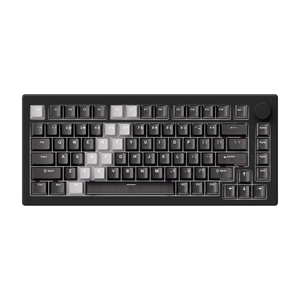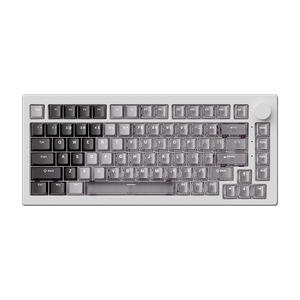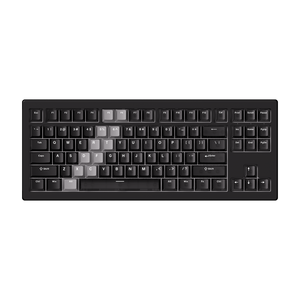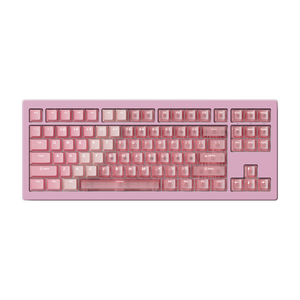What are magnetic keyboards?
A magnetic keyboard is a keyboard with magnetic switches that use magnetic fields to detect keystrokes.
The internal structure of a magnetic switch consists of a plunger, a magnet, and a spring. The Hall sensor is located on the PCB (printed circuit board).
How it works:
When a key is pressed, the magnet moves closer to the Hall sensor . This changes the magnetic field , triggering a signal to register the keystroke.

How do magnetic keyboard switches work?
First, let’s take a look at the components of a magnetic switch:
- Magnets : Small magnets are attached to the key stems.
- Hall effect sensors : Sensors under the keys that detect changes in the magnetic field.
- Keycaps and housing : The keycaps cover the switches, while the housing contains and stabilizes the switch mechanism.

Key press:
When a key is pressed, the magnet moves closer to the Hall effect sensor, changing the magnetic field around the sensor.
The sensor detects this change and generates an electrical signal that is proportional to the magnetic field strength.
This signal is processed by the keyboard controller and registered as a keystroke.
Releasing the button:
As soon as the button is released, the magnet returns to its original position .
The magnetic field returns to its original state .
The Hall effect sensor detects this change and sends a signal to the controller to register the release of the key .
What are the main features of a magnetic keyboard?
1. Rapid Trigger
Quick-actuation is one of the standout features of a magnetic keyboard. This technology enables ultra-fast response times by minimizing the actuation distance. Gamers, in particular, benefit from this feature, as it ensures fast and precise keystrokes in intense gaming situations.
What are Rapid Trigger Keyboards?

2. Adjustable operating distance
Akko magnetic switches offer precise adjustment of the actuation point for each key. The distance can be adjusted from 0.1 mm to 4.0 mm in 0.1 mm increments. This flexibility allows both gamers and prolific typists to individually optimize their keyboard and adapt it to their needs.

3. Dynamic key assignments
Akko magnetic keyboards support dynamic keystrokes, which can be configured via our software. This feature allows you to assign up to four different actions to a single key, allowing you to efficiently use customized commands and keyboard shortcuts. This improves control over keystrokes and streamlines your workflow.

4. Mod-Tap (double function button)
With Mod-Tap, a single key can perform two different functions—depending on whether it's pressed briefly or held for a long time. This feature allows you to create efficient key combinations and reduce the complexity of key mappings. Especially on compact keyboards, Mod-Tap maximizes the use of each individual key.

5. Toggle Key
With the Toggle Key function, any key can be transformed into a dynamic switch. This feature allows a key to be either permanently activated or automatically triggered multiple times at a specific frequency—similar to a rapid, high-frequency tap. This increases efficiency and precision in various applications.

Why use a magnetic switch keyboard?
1. Faster keystrokes
Unlike mechanical switches, where each key has a fixed actuation point and a fixed reset point, magnetic switches allow for individually adjustable key travel. This allows for quick presses and releases, resulting in increased typing speed.
2. Individual customization
Magnetic keyboards allow users to adjust the actuation point (the distance a key must travel before registering) and the actuation force (the force required to press). This fine-tuned sensitivity can be customized via software, providing a highly personalized user experience.
3. Consistent performance
Because magnetic switches rely on a magnetic field rather than mechanical components, they are not subject to mechanical wear. This means that the actuation force and trigger point of the switches remain constant throughout their entire service life.
4. Smooth typing experience
Because magnetic switches don't require metallic spring mechanisms like conventional mechanical switches, the keys move particularly smoothly up and down. Whether with soft or firm springs, the typing experience remains pleasant and comfortable.
5. Longevity
Thanks to electromagnetic technology and the lack of mechanical wear, magnetic switches have a significantly longer service life than conventional mechanical switches.

Who is the magnetic keyboard suitable for?
The quick-trigger function of the magnetic switch is specifically designed for FPS shooter games and music rhythm games, such as OSU players, who need a single button to send commands quickly and in large quantities.
So if you are an FPS gamer or a music rhythm gamer, the magnetic switch is a good accessory to help you play the game better.
If you're a gamer who uses a small number of keys frequently, the magnetic switch can extend the lifespan of the keyboard and prevent you from having to constantly switch keyboards.
Additionally, if you're a heavy typist and still find it difficult to get the overall force feedback of a mechanical keyboard, you can try a magnetic switch keyboard; it will be more comfortable in comparison.

Magnetic vs. Traditional Mechanical Keyboards
technology
Magnetic keyboards use magnets and Hall-effect sensors to detect keystrokes without physical contact—this is known as contactless actuation. In contrast, mechanical switches use metal contacts and springs, registering keystrokes through physical contact between the metal components.
Adjusting the actuation point
Magnetic switches often allow for adjustment of the actuation point, i.e., the distance a key must travel to register a keystroke. Mechanical switches, on the other hand, have fixed actuation and reset points that cannot be changed.
Benefits for gamers
With adjustable actuation points, magnetic switches support features like Dynamic Keystroke (DKS) and Rapid Trigger (RT), enabling faster response times in games. While mechanical switches offer excellent tactile and audible feedback, they are often preferred for office use, providing a consistent and satisfying keystroke feel.
Magnetic switches offer flexibility and precise control, making them ideal for gaming enthusiasts, while mechanical switches excel in the typing experience and are well-suited for office and everyday use. Choosing the right switch depends on your specific needs.

Magnetic vs. Optical Switch Keyboards
Both magnetic and optical switch keyboards are durable because their respective designs minimize wear and tear. However, there are some differences between them.
How it works
Optical switches use infrared light beams to detect key presses. When the key isn't pressed, a barrier blocks the path between the light beam and the sensor, making the sensor act like an off switch (no connection). When the key is pressed, the barrier moves, allowing the light to reach the sensor. Now, the sensor behaves like an on switch, allowing current to flow through the key.
Magnetic switches use magnets and Hall-effect sensors for contactless actuation.
Reaction time
Based on their operation, we know that optical switches rely on the interruption of light, which is inherently fast and precise. Compared to a magnetic switch, the actuation speed of an optical switch is faster.
Adjustment
As mentioned above, magnetic switches offer the ability to adjust actuation and reset points. In contrast, optical switches typically have fixed actuation positions.
Typing experience
Magnetic switches focus on smooth operation and durability, while optical switches prioritize speed and precision.
Due to the differences mentioned above, optical switches are ideal for gamers who require fast actuation. Magnetic switches, on the other hand, are best for those seeking adaptability and versatility for both gaming and typing.
Frequently asked questions about magnetic switches
Are magnetic switches good for typing?
Yes, magnetic switches are good for typing. They offer a smooth, low-fatigue typing experience because they allow for adjustable key travel and have fewer physical contact points, resulting in greater durability . These features make them comfortable and efficient for longer typing sessions.
What else is a keyboard with magnetic switches called?
Keyboards with magnetic switches are also called Hall-effect keyboards . The name derives from the Hall-effect sensors used in some magnetic switches to detect keystrokes.
What type of plate does a keyboard with magnetic switches use?
Metal plates are commonly used in keyboards with magnetic switches. The metal plate provides a stable foundation and ensures the stability of the switches, providing a consistent typing and gaming experience. Using PC/POM plates for stability is not recommended, as they lack the necessary rigidity to properly hold the switches in place. Because magnetic switches have such fast response times, even a small shift can have a significant impact on their performance.















